Welcome to Jaipur
The Pink City
JAIPUR
Jaipur is the capital of India’s Rajasthan state. It evokes the royal family that once ruled the region and that, in 1727, founded what is now called the Old City, or “Pink City” for its trademark building color. The story goes that in 1876, the Prince of Wales visited India on a tour. Since the color pink was symbolic of hospitality, Maharaja Ram Singh of Jaipur painted the entire city pink. The pink that colors the city makes for a marvellous spectacle to behold. At the center of its stately street grid (notable in India) stands the opulent, colonnaded City Palace complex. With gardens, courtyards and museums, part of it is still a royal residence.
The city has a very rich and 5000 year's old history that starts with the arrival of the Pandavas. The city is also a witness of the different wars particularly the Indian war of independence. It was made the capital of the nation by the Britishers.Planned by Vidyadhar Bhattacharya, Jaipur holds the distinction of being the first planned city of India.Renowned globally for its coloured gems, the capital city of Rajasthan combines the allure of its ancient history with all the advantages of a metropolis. The bustling modern city is one of the three corners of the golden triangle that includes Delhi, Agra and Jaipur.
ITINERARY :DELHI-JAIPUR-DELHI (3 Days/2 Nights)>>
- No of Days: 3 Days
- Package Cost : 400Euros
- Tour Starts by : 06:00 am
- Distance & Hours: 250kms - 5 hours
DAY-1 : Jaipur
|
DAY-2 : Jaipur
|
DAY-3 : Jaipur
|
Jaipur Culture at a Glance...........
With grand palaces, historic city walls and buzzing streets, Jaipur, aka the Pink City (named for the color of the buildings at its historic centre), is the perfect stop as part of a larger North India tour. It’s the most complex and largest of the cities in Rajasthan, though it’s perfectly possible to navigate solo or as part of a small group. Its modern offerings, juxtaposed with centuries-old institutions and bazaars, make it a haven for design junkies and foodies. Experience the boom in contemporary cafes and bars and upscale textile and clothing boutiques – and leave room in your luggage for bargain and luxury finds.
Entry Gates of the City:
Apart from its rich culture and royal heritage, Jaipur is also famous for the old city gates which are also known as Jaipur gates are hard to miss. These gates marked the outer periphery of Jaipur city as laid out by Maharajah Sawai Jai Singh IIduring the founding of this city in 1727 AD. As per the plan, a 6-meter high and 3-meter thick wall surrounded Jaipur, containing the city within. This wall acted as a security feature, protecting the city its inhabitants from any outside threats like attacking armies, wild animals, and dacoits etc.
Any movement in and out of the city was routed through these gates. Initially, the city was protected by 8 gates in all four directions. These gates would close at dusk and open only after dawn. To alarm all citizens in the evening about the impending closure of gates, a small cannon would be fired in a similar fashion to the sounding of bells. Today, these gates are merely symbolic; part of city’s history, Nostalgia and built heritage. However, they are also an important element of Jaipur’s rich architectural legacy for which city is famous across the world.
Monuments to witness in Jaipur:
|
|
|
Places to Visit in Jaipur with Short Descriptions:
Amer Fort
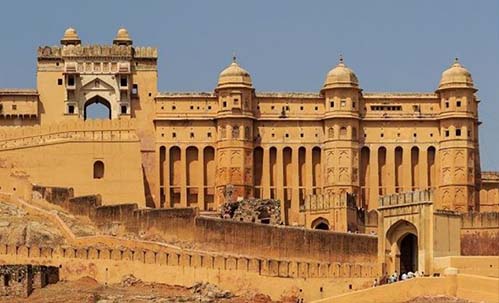
The Amber (pronounced Amer) is at a distance of about 11 kilometres from Jaipur. Now a UNESCO World Heritage Site, it was the bastion of the Kachwahas of Amber, until the capital was moved to the plains, to what is today Jaipur. The palace, located in craggy hills, is a beautiful melange of Hindu and Mughal styles. Raja Man Singh I began construction in 1592 and the palace, which was built as a strong, safe haven against attacking enemies, was completed by Mirja Raja Jai Singh. The contrast between the harsh exterior and the inviting interior couldn’t be more surprising. Made entirely of red sandstone and white marble, visitors are left spellbound by the magnificence of the palace that utilises carvings, precious stones and mirrors. The splendour of the palace is enhanced by the breath-taking vista of the Maota Lake in front. The palace is nearly seven centuries old and has a legendary past. Originally a small structure that the Rajputs won from the Meena tribes, it was later transformed into the grand Amber Palace.
City Palace
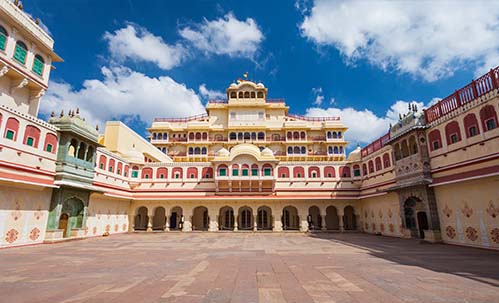
Located deep within the walled city, the City Palace Complex was conceived and built by Maharaja Sawai Jai Singh II, the founder of Jaipur. A beautiful fusion of Mughal and Rajput architecture, the palace is still home to the last ruling royal family which lives in a private section of the palace. Maharaja Sawai Jai Singh II is credited with building most of the structures, but it was expanded upon by later rulers as well. The City Palace Complex includes the Mubarak Mahal (the palace of reception) and the Maharani’s Palace (the palace of the queen). Mubarak Mahal now houses the Maharaja Sawai Man Singh II Museum and displays a vast and unique collection of royal costumes, delicate Pashmina (Kashmiri) shawls, Benaras silk saris, and other dresses with Sanganeri prints and folk embroidery. The clothes of Maharaja Sawai Madho Singh I are also on display. The Maharani's Palace, surprisingly, has an interesting display of very well-preserved Rajput weaponry, some dating back to the 15th century. Other than the arms, the palace is adorned with beautiful paintings on the ceiling that are well-maintained.
Hawa Mahal
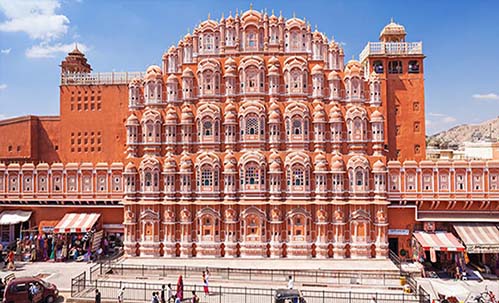
Hawa Mahal, literally the Palace of Winds, was built in 1799 by the poet king Sawai Pratap Singh as a summer retreat for him and his family. It also served as a place where the ladies of the royal household could observe everyday life without being seen themselves. This unique five-storey structure is a blend of Hindu and Islamic architecture, and the exterior, with its small latticed windows (called jharokhas), resembles the crown of Lord Krishna. The windows also serve as an air-conditioner of sorts, blowing cool air throughout the palace, making it the perfect retreat during summers. Built from pink sandstone, the Hawa Mahal is Jaipur’s iconic landmark and visitors can view its complete magnificence from outside, from across the road. However, it is also possible to climb right up to the top for a wonderful view from the windows. Today, the Mahal is maintained by the Archaeological Department of the Government of Rajasthan and also houses an archaeological museum in the courtyard.
Nahargarh Fort
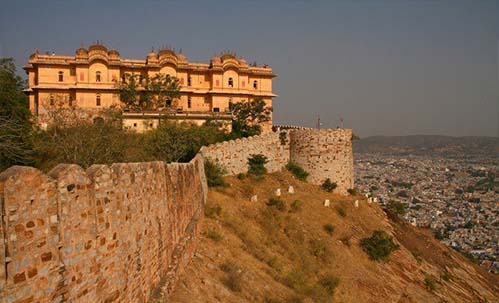
Nahargarh Fort sits proudly on a ridge of the Aravalli Hills, creating an impressive northern backdrop to the city of Jaipur. It was constructed during the reign of Jai Singh in 1734, and was later expanded in 1868. Nahargarh, which means abode of tigers, was a formidable barrier, defending Jaipur against attacking enemies. Within its walls, the fort houses Madhavendra Bhawan, the summer destination for the members of the royal family. Built by Sawai Madho Singh, the palace has 12 matching boudoirs for the queens, at the head of which is a suite for the king. They are all connected by corridors decorated with delicate murals. Even today the palace is a favoured spot for local picnickers. The fort looks brilliant when floodlit at night. Overlooking the city, it presents a glittering view of the city lights.
Jal Mahal
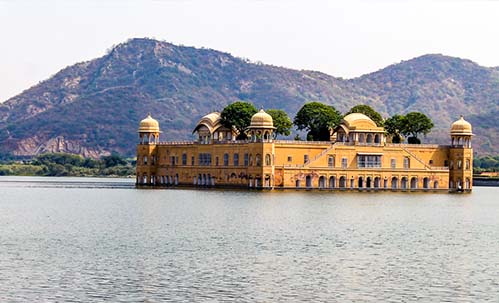
Jal Mahal (meaning "Water Palace") is a palace in the middle of the Man Sagar Lake in Jaipur city, the capital of the state of Rajasthan, India. The palace and the lake around it were renovated and enlarged in the 18th century by Maharaja Jai Singh II of Amber. The most serene sight amidst the chaos of Jaipur is the beautiful Jal Mahal Jaipur. The Jal Mahal is 4km to the north of Jaipur and is located on the main Amer-Jaipur road. Most visitors to the Jal Mahal combine the visit with the Amer fort as both attractions are on the same side of Jaipur.
Jantar Mantar
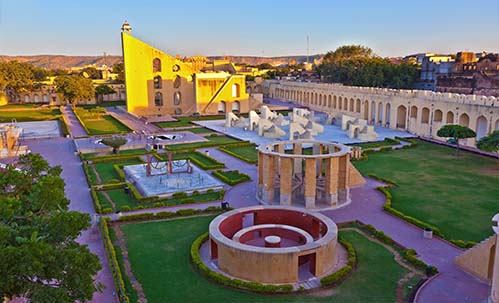
Now a UNESCO World Heritage Site, Jantar Mantar in Jaipur is considered to be the largest of the five astronomical observatories built by Maharaja Sawai Jai Singh II, the founder of Jaipur. It contains sixteen geometric devices, designed to measure time, track celestial bodies and observe the orbits of the planets around the sun. It also houses the Interpretation Centre that helps the tourists to understand about the working principles & chronolgy of the observatory.
Albert Hall Museum

The building gets its name from The Victoria and Albert Museum in London, the inspiration for its design. The exquisitely built Albert Hall is housed in the centre of Ram Niwas Garden. Sir Swinton Jacob (who is also the mastermind behind many other palaces in Rajasthan) conceptualised and designed it using styles from the Indo-Sarcenic architecture and the Prince of Wales laid the foundation stone of the building in 1876.The museum displays a wide range of metal objects, wood crafts, carpets, stone and metal sculptures, arms and weapons, natural stones and ivory goods. It also houses a large collection of miniatures from Bundi, Kota, Kishangarh, Udaipur and Jaipur schools of art.
Jai Garh

Jaigarh Fort is situated on the promontory called the Cheel ka Teela of the Aravalli range; it overlooks the Amer Fort and the Maota Lake, near Amer in Jaipur.Located on the Hill of Eagles, Jaigarh fort was built in 1726 AD by Sawan Jai Singh II.Jaigarh Fort is located at a height of 500 feet above sea level.About 15 kilometres from Jaipur, Jaigarh Fort was built by Sawai Jai Singh II sometime in the early 18th century amidst the arid, rocky and thorn-scrub covered hills. Despite its ancient construction, it still retains most of its imposing citadel appearance. Visitors can see the world’s largest cannon Jaiban, at the fort.
Birla Mandir
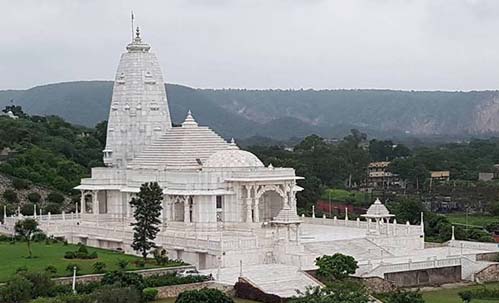
The Lakshmi-Narayan Temple, or the Birla Temple, as it is more popularly known as, is located at the base of Moti Dungari. Built on an elevated platform, this comparatively modern temple is built entirely of white marble and dominates the skyline of south Jaipur. The temple was commissioned and built by renowned Indian industrialists, the Birlas, in 1988. The temple is dedicated to Lord Vishnu, also called Narayan, and his companion, Lakshmi, the Goddess of wealth and good fortune. The temple is a work of art and has a marvellous display of exquisite carvings and sculptures covering many mythological themes. The eye is drawn to the images of Laxmi and Narayan, carved as they are, from one piece of marble. The top of the temple has three domes, each representing the three religions followed in India. This is designed to pay homage to secular India. The temple looks spectacular at night when it is lit up. Other than the main temple, the complex has a museum that exhibits the earlier belongings of the Birla family.
Sisodiya Rani Palace & Garden
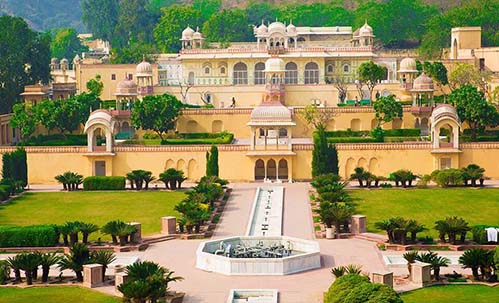
The garden was built in 18th century by Maharaja Sawai Jai Singh for his second queen Sisodia Rani, Udaipur princess. This garden was used by the queen for relaxing. The garden was decorated with mural painting of Lord Krishna and Radha to express the love that the king had for Sisodia Rani. The garden was specifically built outside the city to keep it away from the hustles and noises of local life. The garden is designed with a mixture of Indian style and Mughal architectural style. The spires and pavilions of the garden are designed in the Indian style. The wall paintings and decorations are also a form of Indian style. The flowerbed arrangement, water channels and fountains are designed in Mughal style. There is a small shrine and a natural spring near the garden that are dedicated to Hindu Gods; Lord Shiva, Lord Hanuman and Lord Vishnu.
Vidyadhar Garden
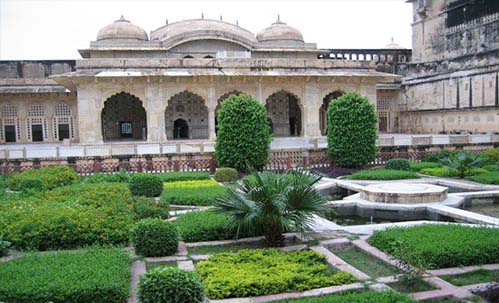
It is planned according to the ancient scripts of Shilpa Shastra.The garden is totally a visual treat for the visitors with its pleasing greenery and amazing artwork done on the walls and roofs of the pavilions and galleries. The garden is surrounded by the hills with the covered lights creating a magical charisma in the evening. The walls are decorated with magnificent lattice and mirror artwork, leaving the visitors speechless. Images and scenes from the life of Lord Krishna are imposed on the walls to give divine look and feel to the garden. Dancing peacocks, fountains and fresh greenery make the place worthy to visit.
Isar Lat / Swargasuli
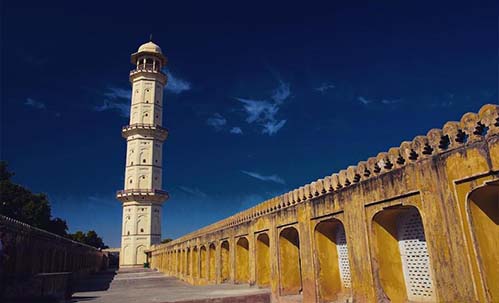
Isar Lat or the heaven piercing monument was built by Sawai Ishwari Singh in the year 1749. Ishwari Singh achieved victory over the combined armies of Mewar and the Marathas. He was engaged in a war with them because they were supporting the claims of Madho Singh, his rival to the throne of Jaipur.The minaret is seven storied and once you reach the top of this tower you will get a wonderful opportunity to get a glimpse of the whole city.
Elephant & Camel Rides

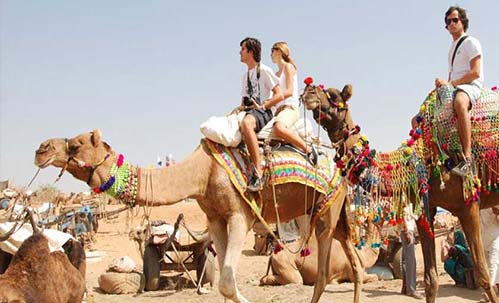
Central Park
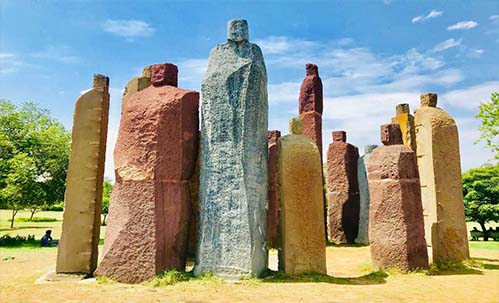
Central Park is a large green zone right in the centre of Jaipur that offers city dwellers a spot for a moment of respite. Conceptualised and built by the Jaipur Development Authority, it is Jaipur’s largest park. It houses a lush garden, the Polo Ground and a golf club. However, the highlight of the park is India’s first all-day-and-all-night monumental National Flag which also happens to be the country’s tallest flagpole.
Handprinting
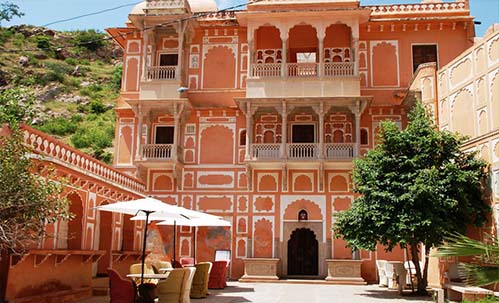
At a mere ten-minute walk through the cobbled streets of Amber lies the Anokhi Museum of Hand Printing. Located in a magnificently restored haveli (mansion), the museum displays a varied selection of block-printed textiles alongside images, tools and related objects all chosen to provide an in-depth look into the complexity of this ancient tradition.
Moti Doongri Ganesh Temple

Moti Doongri is a small hill around which the city of Jaipur flourishes. Moti Doongri means pearl hill, because the hill indeed resembles a pearl drop. Visitors go there to pay homage at the famous Ganesh temple, the most auspicious and important religious temple in Jaipur. The Ganesh temple was built by Seth Jai Ram Paliwal, sometime in the early 18th century. A legend goes, the King of Mewar was heading back to his palace after a long journey and was carting a massive Ganesh idol on a bullock cart. The king had decided that he would build a temple for the idol of Lord Ganesh wherever the bullock cart stopped. Apparently the cart stopped at the foot of the Moti Doongri, which is where the temple is situated today. The hill also has an exotic palace perched right on top. A replica of a Scottish castle, it was once the royal home of Maharaja Sawai Man Singh. It continues to belong to the royal family. The mere view of this castle is extremely exotic.
Govind Temple
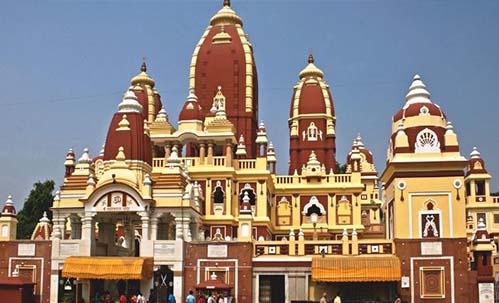
The Krishna temple is a rare spire-less temple and houses the idol of Govind Devji that Sawai Jai Singh brought from Vrindavan. The deity, worshipped by the erstwhile royal family, is also revered by the the locals in the area.
Digamber Jain Temple
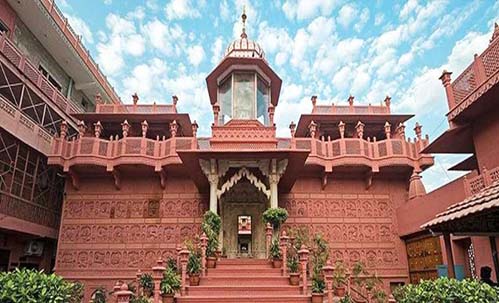
The ancient Digamber Jain temple at Jaipur is in Sanganer, 14 km from the city. The principal idol in the Sanghiji Temple is of Lord Adinath in the Padmasan (lotus position) posture. The temple is made of red stone and has attractive carvings. The seven-storied temple has sky-high 'shikharas' (spires) and its inner sanctum is a stone shrine with eight sky-high shikharas.
Galtaji
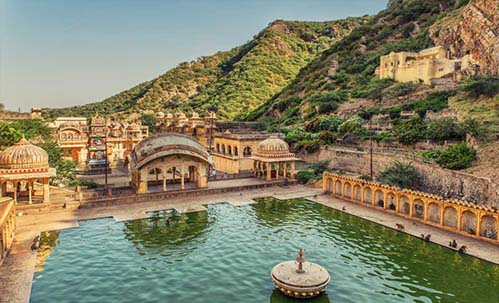
Galtaji is an ancient pilgrimage centre in Jaipur. Set amidst low hills and packed with locals and tourists alike, the attractive spot has temples, pavilions and holy kunds (natural springs and water tanks). Visitors to Galtaji will come across the complex of Ramgopalji temple, locally called the Monkey temple (Galwar Bagh). It gets this moniker because of a large group of resident monkeys. The green landscape and chattering monkeys add to the delight of the area. On top of the hill is a small temple dedicated to the sun god, called the Surya Mandir. Constructed by Diwan Kriparam, the temple can be seen from anywhere in the city.
Kanak Vrindavan

Located at the foothills of Nahargarh hills on the way to Amber, Kanak Vrindavan is popular among the locals for picnics. The beautifully landscaped garden houses an intricately carved temple, several terrace sites, marble columns and lattices, making it a dream location for film shoots as well.
Jaipur Wax Museum

Amidst the confines of the Nahargarh Fort at the foothills of the Aravallis lies the Jaipur wax museum, a visit of which is sure to leave you awe-struck! It has been developed by Entertainment 7 Ventures Pvt Ltd. Hosting over 30 wax statues of famed personalities, the museum is a spectacle to behold! The wax museum, as the name suggests, holds wax statues of many leading personalities such as Amitabh Bachchan, Mahatma Gandhi, Bhagat Singh, Rabindranath Tagore, Albert Einstein, Michael Jackson, Sawai Jai Singh II, Maharani Gayatri Devi and many Indian and International leads. The life-like replicas along with detailed backdrops and ingenious sets provide an overwhelming yet unique experience. The museum also has a display of the 10 foot long Bullet, Gati Gamini, the signature Rajasthan Tourism Motorbike. The timing for the wax museum and sheesh Mahal is from 10 am to 6.30 pm and open all days of the week, The ticket price per person for wax museum and Sheesh Mahal is Rs 500 for Indians, and Combo entry for International Travellers is Rs 700 for all days.
